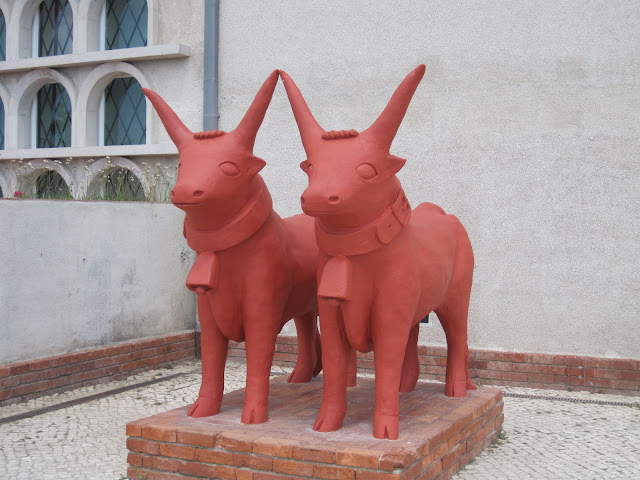My second day took me by tram to Belem, where a heavy concentration of historical sites can be found. Plus, it has sweets. I missed my tram stop so I had to back track a few blocks for my first taste of the very popular Portuguese pastry pastel de nata (aka pasteis de Belem). Casa Pasteis de Belem has been making these egg custard treats since the 1820s. They originated at the Mosteiro dos Jeroninmos, which I visited later that day, in the 18th century. To anyone who has ever had dim sum, they might look familiar. Apparently, dantat is a derivative of pastel de nata, which makes sense since Macau was a Portuguese colony.
Enough of food history, these pastries look similar but they do not taste like dantat. The crust in particular is much more crunchy and flaky than the dim sum version.
 |
| A bica (espresso) and two pasteis de belem |
My first historical site of the day was the Museu Nacional dos Coches (National Coach Museum). The museum was created by the Queen in the early 1900s as a way to preserve the historical vehicles and share them with the public.
The majority of the carriages were ceremonial but there were also a number of functional examples. Many of them feature intricate carved woodwork.
 |
| National Coach Museum |
Next was the highlight of my day: Mosteiro dos Jeroninmos. The architecture is a distinct Portuguese late gothic style known as Manueline. Much of the Manueline architecture was destroyed in the earthquake of 1755 but the monastery still stands.
 |
| Exterior of Mosteiro dos Jeroninmos |
 |
| Exterior of Mosteiro dos Jeroninmos |
The cloister was my favorite part of the monastery and I could see how this environment could be conducive for a spiritual life.
 |
| Main chapel on Exterior of Mosteiro dos Jeroninmos |
 |
| Monument to the Discoveries with 25 de Abril Bridge in the background |
A waterfront path leads you to Torre de Belem, which was my last stop on my tour of Belem. These two cows were hanging out in front of a museum along the way.
Torre de Belem is another example of Manueline architecture. Built in the 1600s, the tower was part of the defensive system. Climbing to the top of the tower proved difficult as it was very crowded with only a single stairway to take people both up and down. I eventually made it to the top though.
I picked Porta d'Alfama because I had read in a number of places that they have afternoon fado on Saturdays. I was to find that this was not true. Oh well, at least the food was good.
I had an octopus salad and the soup of the day.
 |
| Octopus salad from Porta d'Alfama |
Just as I was finishing my meal, it started to rain, so I quickly snapped some photos of the Alfama area. This small alley was decorated with tinsel for some reason.
 |
| Alley in the Alfama |
Here is how the rose window looks from the inside.
I also visited the cloisters which as you can see have been undergoing some excavation.
The galleries surrounding the cloisters feature statues and sculptures dedicated to saints. This was one of my favorite pieces that I saw.
The cathedral was not very busy so it was easy to enjoy its tranquility and beauty.
I spent the remainder of my afternoon souvenir shopping. If you ever find yourself in Lisbon, I recommend A Arte da Terra. This shop features only Portuguese-made items and handicrafts so you can be sure you are supporting local artisans and also taking something home that is made in Portugal.
Before heading back to my hotel, I made a quick stop at Eduardino, another ginjinha shop! Saude! This place is supposed to be the most authentic but I couldn't tell you the difference. Maybe it's the plastic cup?
For dinner, I went to Ze Varunca. This is a restaurant that is difficult to just stumble upon because it is off a back street. The restaurant feels very homey and quaint.
One main difference between American and Portuguese meals is that a lot of stuff is brought to your table that you didn't order and which you are charged for if you touch. If you don't touch it, you don't get charged for it. Even bread and butter cost extra. For this meal, I just had bread and my main entree but at other meals, I did eat the appetizers which usually include olives, cured meat or fried things.
Before leaving Portugal, I had to have balcalhau (salted and dried codfish), which is considered the national dish of Portugal. I heard people say there are 365 recipes to prepare balcalhau for each day of the year. It should also be pointed out that codfish is not a local fish, so the national dish is an import!
I had a version that was baked with spinach and cheese. Not my favorite thing in the world but I had to try it.
Rua de Belem 84
1300-085 Lisbon
Portugal
Porta d'Alfama
Rua de Sao Joao da Praca 17
Largo das Portas do Sol
1100 Lisbon
Portugal
Ginjinha Sem Rival/Eduardino
Rua das Portas de Santo Antao 7
1150-277 Lisbon
Portugal
Ze Varunca
Rua de Sao Jose 54
1150-323 Lisbon
Portugal
You might also like:
Portugal: Part 1 - Obrigada - only word I learned
Portugal: Part 3 - Cold and Rainy in Sintra
Portugal: Part 4 - The Rest













No comments:
Post a Comment